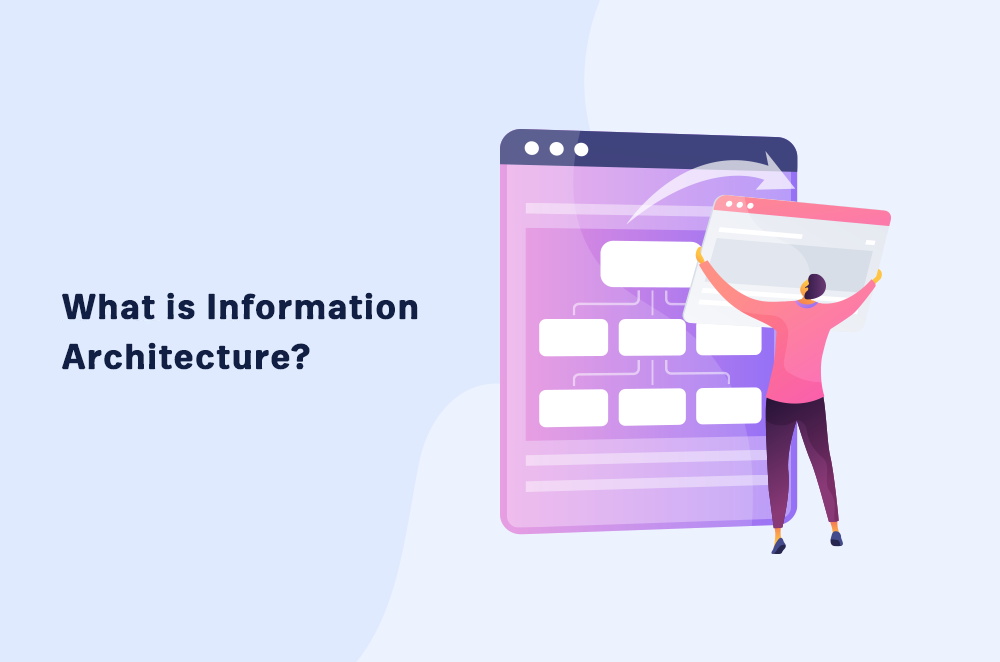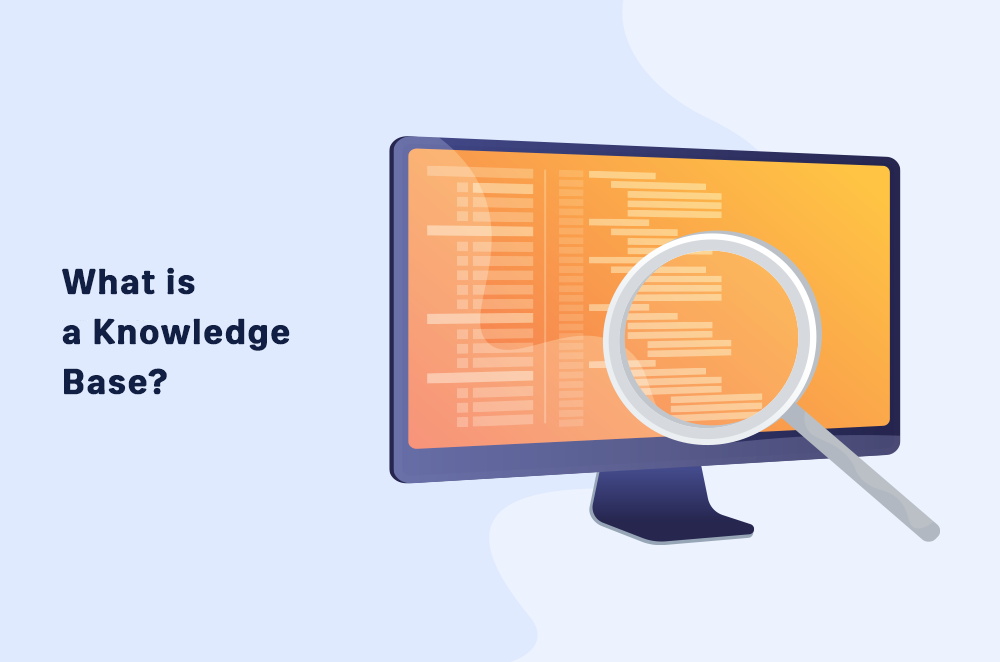Information architecture (IA) is the process of organizing, structuring, and labeling content to complement the structural design of shared information environments.
The idea is to improve sustainability and effectiveness while helping users find information more efficiently.
As long as your users are able to complete their tasks effectively and efficiently, you’re doing a good job with your information architecture.
But, to further improve upon your processes, you need to understand how information architects work.
In this article, we’ll go over what information architecture is, its methodologies, principles, and more.
Let’s get started.
What Exactly is Information Architecture?
According to the Information Architecture Institute, information architecture (IA) is the process of deciding how to arrange the parts of anything so that it can be understandable.
Generally, that can apply to practically anything. However, information architecture today mostly relates to content and user experience.
While it’s a valuable and necessary field, you won’t see an information architect role in most cases. Even though the role transcends multiple roles, including that of a content strategist and UX designer.
If we were to summarize the concept of information architecture, it would be about helping people understand their surroundings. The goal is to help them find what they’re looking for easily and efficiently.
It’s called information architecture because you arrange the information in a sequence that’s easy to understand. For example, site map creation is a part of information architecture as it needs to follow a user-centered design to make sure users can find the links they need easily.
Similar to site maps, any sort of optimization you see on the world wide web is part of IA. All the pages you see on a website are part of its IA. Each site’s content contributes to the collective experience of the user.
Therefore, to create an efficient user experience, you have to utilize the content inventory accordingly. If you notice how different pages follow a separate format depending on the target audience, you’re already seeing IA in action.
What Does Information Architecture Entail?
Depending on user research and usability testing, you set up the structure of an application, website, or other projects. User interviews, surveys, and secondary sources of information help collect the data to do so.
All of it allows you to figure out where each set of data and information should be for users. Practicing information architecture leads to the creation of categories, hierarchies, site maps, navigation, and metadata.
For example, if your content strategy includes topics that come under different categories, you’re already practicing IA.
Similarly, if a web designer adds a searching system or drop-down menu to help users navigate through a website, they’re also practicing information architecture.
In any case, you have to ask yourself what user flow is like. For each action, a user expects a certain outcome. Your job is to understand what users expect and design the flow accordingly.
That means you’ll have to understand how the app or website manages user information. Furthermore, exactly what information gets back to the user and how users understand that information. Most importantly, you have to understand whether the information is helping users and driving certain decisions.
To realize all of this, information architects have to focus on the target audience, project data, and the technology in place.
Common Methodologies of Information Architecture
While the concept of information architecture began around five decades ago, it now focuses on online content and user experience design.
However, the start of IA is noticeable in library science, cognitive psychology, and architecture.
Library Science
Library science is the development of knowledge organization systems. It’s the process and study of how to categorize, catalog, and locate certain resources within a system.
The concept makes appearances in most systems and places that store various forms of resources, items, and information. That includes traditional libraries, science labs, museums, and even hospitals.
For example, a museum tends to categorize different artifacts according to their geolocations and time periods. Then, they catalog each individual artifact according to what it is, what it represents, and its age. All this information is in a registry (online registry today).
That makes it easy to quickly locate any single artifact within a museum.
For information architects, the process of cataloging is crucial. It details the process of creating metadata and assigning it to certain objects or content so it’s easily searchable in the future. It also helps in structuring content according to specific parameters, like for a search engine.
Other than that, another important part is archival science. It’s the process of creating and curating archives of content. The idea is to edit or remove certain content to maintain the integrity of the archives.
Both these concepts help in creating an information architecture with usable metadata in a well-managed archive.
Cognitive Psychology
Cognitive psychology refers to the study of how human minds work. That includes understanding the mental processes that lead to various actions.
Therefore, it also makes an impression on how we architect different information and we design certain interactions.
Information architects tend to focus on a few key elements of cognitive psychology. That includes the following:
- Cognitive Load – is the total amount of information that any person can process at any given time. There’s always an upper limit to how much information someone can handle at once. Information architects use this to make sure their users never go beyond that point. The idea is to never fully engage a user’s cognitive load to avoid overloading them with too much information.
- Mental Models – include all the assumptions that are present in a user’s mind. That includes all sorts of predispositions, opinions, and assumptions about a website or application. It’s relevant in IA because it’s always easier to discover and understand information that matches a user’s mental model.
- Decision Making – is all about making a choice out of several options. Information architects can drive the decision-making process by providing certain information at key points in a user’s journey.
The use of IA design patterns, website content, and UX design often lead to driving certain behaviors and actions.
Architecture
The concept of information architecture came from Richard Saul Wurman who was a graphic designer and architect. According to him, creating IA is all about structuring information like a building’s structure – using a robust foundation.
The idea is that the presentation of information is often more important than the information itself. When you structure information, you provide viewers with an outlook of what you want them to see.
The information structure only makes sense if you want it to make sense. Therefore, it’s up to you how to decide how it should make sense to the user.
However, in all cases, there should be an intentional flat structure with a precise and solid foundation of ideas.
Principles of Information Architecture
Similar to web design, building the information architecture should also not be a separate task. That’s because there are a lot of things to take into account.
IA development goes through a strict hierarchy pattern and research phase. There are usability tests, interviews, and more when other team members like UX designers pitch in.
Some factors to take into account include user behavior and the future-proofing of the IA. In any case, there’s a lot that goes into IA than just organizing information and data logically.
While information architecture diagrams help, there is a need for certain rules. These rules help in such a way that they act as best practices.
That’s why Dan Brown, a renowned information architect, came up with 8 principles of IA that can always help design a good site structure.
8 Principles of Information Architecture
The idea is that an information architect should focus solely on the structure. That means everything that is showable through data modeling like maps and flowcharts.
For that, the architect needs access to the complete content inventory and needs an understanding of the site’s functionality. Once they have that, they can begin optimization using the following principles.
- The Principle of Disclosure – entails that there should be a preview of information that helps users understand what kind of information is available. It gives them an idea of what they can find after digging deeper.
- The Principle of Objects – means that all content needs to act as a living thing. In other words, it has behaviors, lifecycles, and attributes.
- The Principle of Exemplars – means that whenever you’re describing any form of content or categories, you should include accompanying examples.
- The Principle of Choices – entails that less is more at all times. That means the choices in any architecture should remain at a minimum.
- The Principle of Multiple Classifications – says that users need several different classification schemes to make sense of a site’s content. More classifications help users differentiate different sorts of content.
- The Principle of Front Doors – entails that you assume that at least 50% of the users will use a different entry point than the landing page or home page.
- The Principle of Growth – says that you should assume that all content on a website will grow and scale. Therefore, the website should be scalable and growth-friendly.
- The Principle of Focused Navigation – means that you need to keep the navigation system simple and straightforward. Don’t mix up different pages and items and use focused navigation.
It’s safe to say that IA requires a lot of effort and constant maintenance to fulfill a user’s goals.
Key Processes for Information Architecture
Every website needs information architecture regardless of whether it follows a single page model or has multiple pages.
That’s because IA acts as the foundation of any website. To create said foundation, you need to create closely connected content that follows a certain content structure.
When you produce content for IA, it’s in the form of an IA document. There are a few steps that go into creating this IA document.
The main components of an IA document include company and user goals. However, you need to start from the very beginning and follow the steps below for ideal results.
Keep in mind that you can take this process and adapt it to non-digital mediums and products too.
1. Define Your Company Goals
To first step to creating IA is to determine your company goals. That means determining why you want to create the information architecture and what you wish to achieve with it.
To do that, you’ll need to work with key stakeholders, team members, and company management. Make sure you involve all relevant parties and that they agree on the final version of the goals.
If you’re not able to determine both of those things, take a step back. Look at the information gathered and decide what’s best.
However, most company goals are about three things. The first is to make more money. That may be through more customers, scaling, or any other avenue.
Secondly, it’s about reducing overall costs. Information science can help reduce all sorts of company costs in various ways.
Thirdly, it’s about helping people and customers make better decisions. That may be through better interaction design, organizing content, or using interactive content. Regardless, the goal is to improve the user experience.
Once you determine the goals, check whether there are any constraints that may affect the goals. For example, you can do a content audit to see how much content actually helps users and find valuable opportunities for improvements.
2. Define the User’s Goals
To get an idea of the user needs, you need to determine who will be using your website. A good place to start is your target audience.
You’ll have to conduct user interviews, create personas, and develop typical scenarios. They will help weed out your users. You’ll have to see whether the current design process and content relate to these users.
For that, figure out what they’re going to do on the website. Then, determine their goals and needs.
It’s best to use a storytelling approach to make visualization easier. It will help with understanding what you’re explaining.
Differentiate the best-case scenarios from the worst-case scenarios. Then, brainstorm ways to avoid and prevent the latter.
Similar to the company goals, think of any constraints the users may have. For example, consider the technology they’re currently using.
3. Analyze Your Competitors
It’s not necessary for you to develop a completely unique information architecture. Tale a step back and analyze your competition.
Not every organization can afford interaction designers, visual designers, graphic designers, and an information architect. That’s why it’s best to first look at what your competitors are doing.
For that, look at how and where they display information. Also, notice the common categories on the main page, accompanying pages, and backend pages.
Then, take a look at the website navigation. Check out the site map, top-down menus, and links on each page.
After that, consider looking at it from a user’s perspective. Differentiate the good from the bad.
Using that information, determine how you can take the bad and turn it into something good on your website.
4. Define the Content
If your website already has content, you should go through it thoroughly. That’s because you’ll be deciding what to keep and to delete.
However, if you’re developing a new website, you can start anew with a clear understanding of what content to put up and how.
If you already have an existing website with content, then start doing the following.
- Full Content Inventory – Start listing down every piece of content on the site. You’ll need a team of people to do this if it’s a fairly large website. A full content inventory means you’ll be including all the pages, media, downloadable content, and interactive content on the website.
- Partial Content Inventory – This is when you don’t need all the content on a website. Focus on the important parts and all the high-level content and resources.
- Content Audit – It’s a quick way to see how much content there is. It’s quick, simple, but doesn’t provide in-depth information. However, it does tell you how useful, effective, and accurate the content is.
In any case, doing a full inventory is always the best option. You go through everything from the landing page copy to the blogs to the contact information.
Using all that information, you start creating the information architecture.
Designing Information Architecture
Once you’re over with the key processes of IA, you can design the IA of your site. Here’s a three-step process you can use.
- Categorize and Label the Content – Once you have a list of all the content, categorize, prioritize, and group it. You can use card-sorting techniques for that. The cards can be features, concepts, or printed terms. Make sure the groups are displayable on the sitemap and menus.
- Define the Navigation System and Create a Site Map – Once you have your content groups, you need to make sure it’s accessible to users. For that, you have to create an IA through a sitemap and navigation system. Present your content groups in a diagram to convert them into a sitemap. Once you have a sitemap, you can develop the navigation system by utilizing UI elements in meaningful ways.
- Conduct User Testing – Once you have the sitemap and navigation system, you can start testing it. You can utilize various testing methods depending on the design phase and goals. One is tree testing where you see whether categories can lead to an answer. It tests how well your titles and links work. Second, you can use closed card sorting to see how well each category name works. They should be easily distinguishable. Third is click testing where you check the function of the UI components and how useful they are. The fourth is usability testing where you see how and why users use a website. The idea is to find out how users prefer finding information.
The methods above are both quantitative and qualitative. That’s why it’s best to run as many tests as possible.
Once your testing is complete, you can finalize your information architecture according to your user needs.
Wrapping It Up
Information architecture is the backbone of every website today. Things like the sitemap and navigation also play a huge role in SEO.
Therefore, information architecture can practically make or break your website. Make sure you make an active effort to create a good IA for all your websites and products.
Most importantly, always make an effort to continue user testing to ensure your IA works well at all times.











